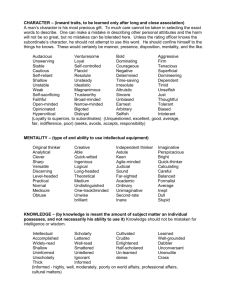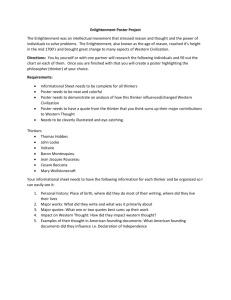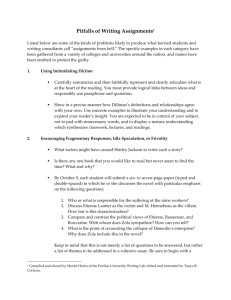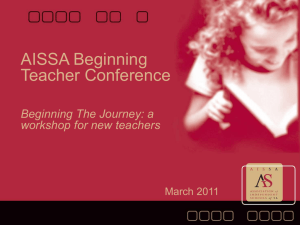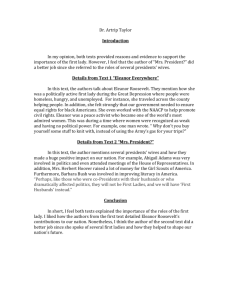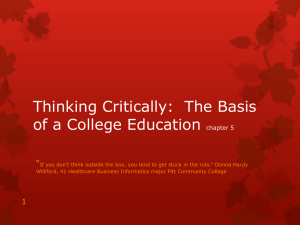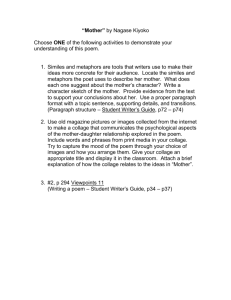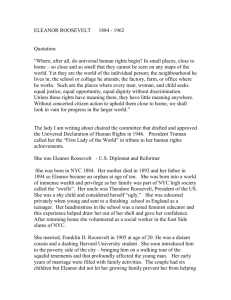Metaphors in “Eleanor Rigby”
advertisement
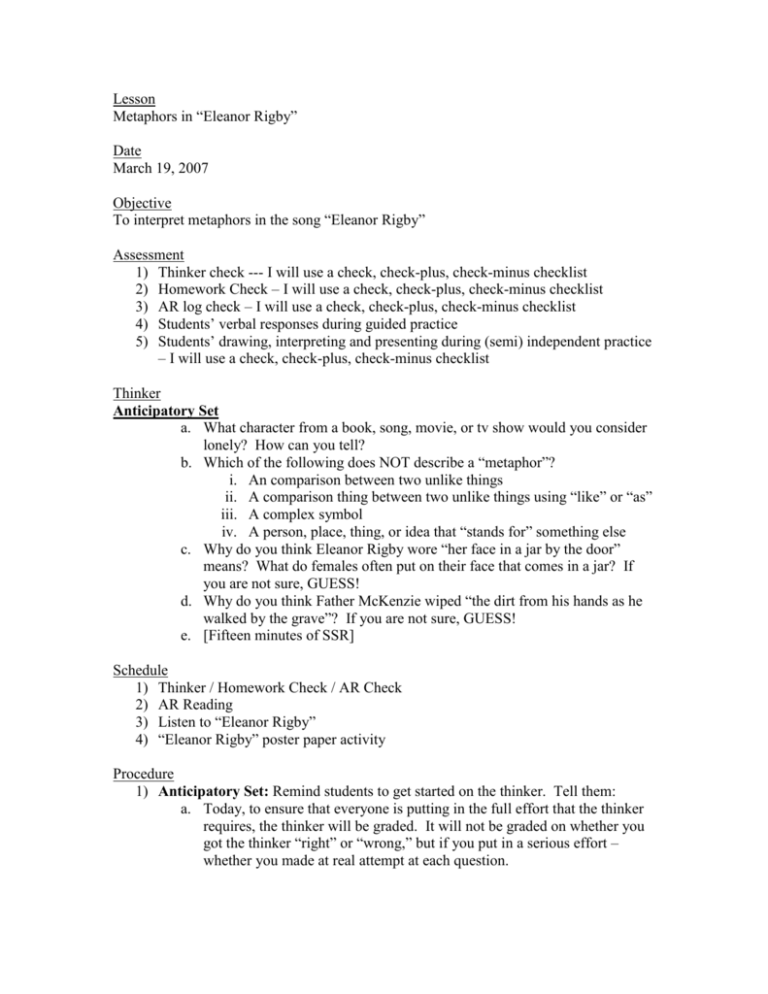
Lesson Metaphors in “Eleanor Rigby” Date March 19, 2007 Objective To interpret metaphors in the song “Eleanor Rigby” Assessment 1) Thinker check --- I will use a check, check-plus, check-minus checklist 2) Homework Check – I will use a check, check-plus, check-minus checklist 3) AR log check – I will use a check, check-plus, check-minus checklist 4) Students’ verbal responses during guided practice 5) Students’ drawing, interpreting and presenting during (semi) independent practice – I will use a check, check-plus, check-minus checklist Thinker Anticipatory Set a. What character from a book, song, movie, or tv show would you consider lonely? How can you tell? b. Which of the following does NOT describe a “metaphor”? i. An comparison between two unlike things ii. A comparison thing between two unlike things using “like” or “as” iii. A complex symbol iv. A person, place, thing, or idea that “stands for” something else c. Why do you think Eleanor Rigby wore “her face in a jar by the door” means? What do females often put on their face that comes in a jar? If you are not sure, GUESS! d. Why do you think Father McKenzie wiped “the dirt from his hands as he walked by the grave”? If you are not sure, GUESS! e. [Fifteen minutes of SSR] Schedule 1) Thinker / Homework Check / AR Check 2) AR Reading 3) Listen to “Eleanor Rigby” 4) “Eleanor Rigby” poster paper activity Procedure 1) Anticipatory Set: Remind students to get started on the thinker. Tell them: a. Today, to ensure that everyone is putting in the full effort that the thinker requires, the thinker will be graded. It will not be graded on whether you got the thinker “right” or “wrong,” but if you put in a serious effort – whether you made at real attempt at each question. 2) 3) 4) 5) 6) b. After I have finished checking your thinker, on the left side of your desk, neatly place your homework and your reading log open to the correct page. I will come around and check both of those. c. After about fifteen minutes of AR reading, we will go over the thinker which will lead us into the song of the day, “Eleanor Rigby.” I will explain the fun activity we will do with that after AR reading. Any questions? (3 minutes) Walk around and check the thinker, homework, and AR logs. (15 minutes) Guided Instruction: Go over the thinker questions. (5 minutes) Play Eleanor Rigby. (3 minutes) Ask for students’ immediate reactions. (2 minutes) Explain the main activity: a. The purpose of today’s main activity is to make sense of the metaphors in “Eleanor Rigby.” You guys did part of the main activity in your thinker. You interpreted “wearing her face in a jar by the door” to mean [whatever they said it meant]. You interpreted “wiping the dirt from his hands as he walked by the grave” to mean [whatever they said it meant]. What you are going to do now is basically the same thing except with markers and colored pencils on poster board. b. Each group is going to get a poster board. Each person in each group has a primary role. One person will be the primary presenter, another will be the primary interpreter, and another will be the primary presenter. It is the primary presenter’s job to present their group’s work to the class when the project is completed. It is the primary artist’s job to make sure that at least four images are colorfully drawn on the group’s piece of poster paper. It will be the primary interpreter’s job to make sure that these the four key components are written next to each drawing: those four, as you’ll see on your sheet in a second, are the specific line from the poem, whether the line is a simile or a metaphor, what the line literally means, and what the line means in the context of the whole poem. c. To get an idea of what each person is specifically supposed to do, flip over your thinker sheet to the side labeled “Examples to Help You Interpret Eleanor Rigby.” So, of the eight possible lines listed, if you chose the line in the poem ““Eleanor Rigby, picks up the rice in a church where a wedding has been / lives in a dream,” you would write on your poster paper: “Line: Eleanor Rigby, picks up the rice in a church where a wedding has been / lives in a dream.” d. Then you would decide whether it is a simile or a metaphor.” Because it does not have “like” or “as,” it would be a metaphor. e. Then you would write down, in your own words, what the line literally means. In this case, that she is the custodian in the church who picks up the rice after other people’s weddings. She daydreams about other people’s weddings as she picks up the rice. f. Finally, most importantly, you would decide what the line means symbolically in the context of the poem. In this case, it would be that “Eleanor’s life has become a lonely dream in which pretends other g. h. i. j. k. l. people’s weddings are her own.” So you would write that down on your sheet. As the primary interpreter is making sure these four key components get written down, the primary artist should be making there is a colorful drawing. The primary presenter should be helping out wherever is needed. The presenter, artist, and interpreter should contribute to the presenting, drawing, and interpreting, but each person will have a primary role to make sure all aspects of the project are taken care of. Now, in thirty seconds, maturely decide who wants to take which role. If your team cannot decide, the person with the closest birthday to January 1st is artist, second closest is interpreter, and third closest is presenter. Ok, decide quickly and maturely. [Give them thirty seconds] Are there any questions? [Go through the second example] Are there any questions? We may not get to all of the presentations today, but it is important to work concentratedly so we can get to as many we can today, so we will have enough time for “The Sound of Silence” tomorrow. Remind students that they will be using the other side of the same paper tomorrow, so be careful with it! Any questions? Ok, go. (8 minutes) 7) Assessment: Monitor students’ progress by filling out the check, check-plus, check-minus sheet. Specifically assess for the artist and interpreter today. When the presenters present (mainly tomorrow), assess them. 8) Ten minutes before the end of class, stop the groups and go over the homework: a. Write a story about the loneliest moment of your life. Make sure it is at least ten sentences and at least two similes and two metaphors. Circle the similes and metaphors in your story. b. Write a poem about the loneliest moment of your life. Make sure it is at least ten lines and at least two similes and two metaphors. Circle your two similes and two metaphors. c. Bring in another song or poem that deals with loneliness. Circle two similes and two metaphors in it. (2 minutes) 9) Spend the remaining time beginning students’ presentations. Check off presenter’s presentation in the appropriate boxes. (7 minutes). 10) Sign planners on the way out. (1 minute)
